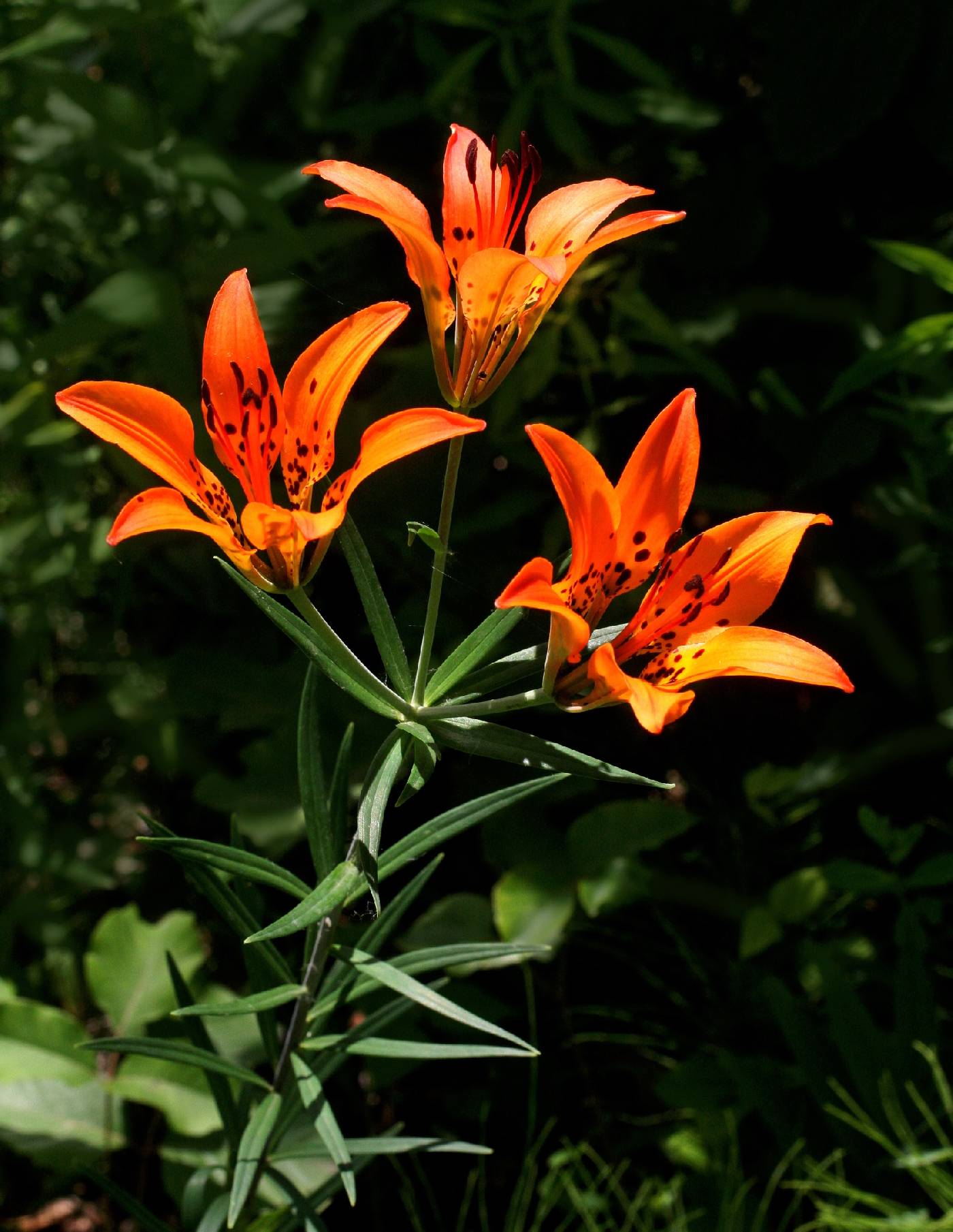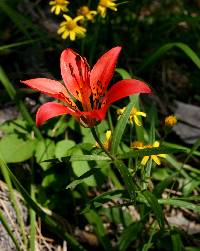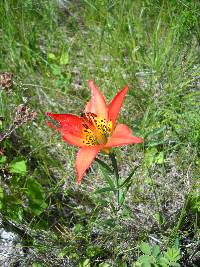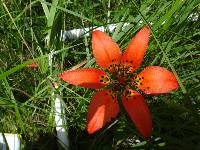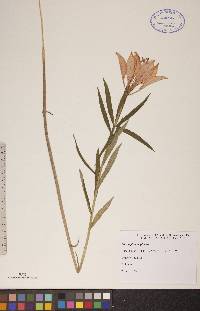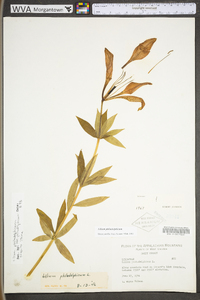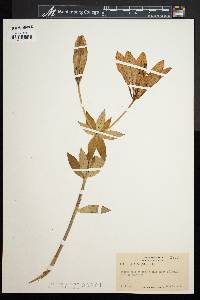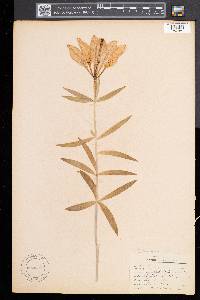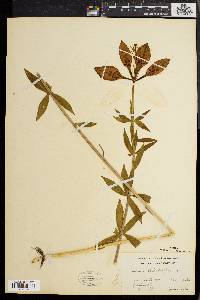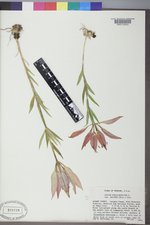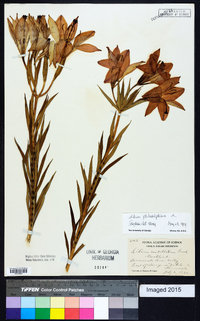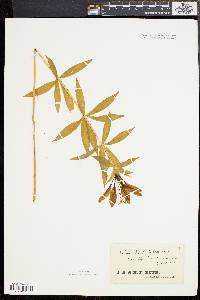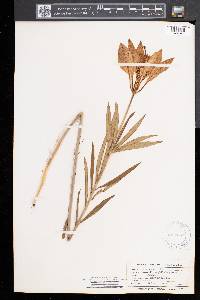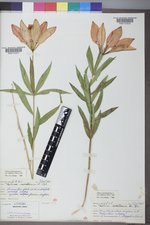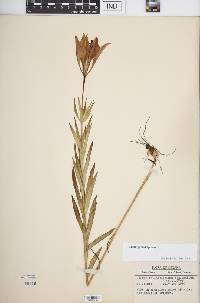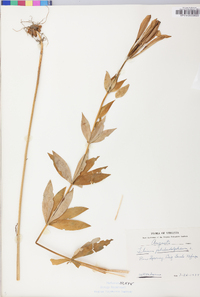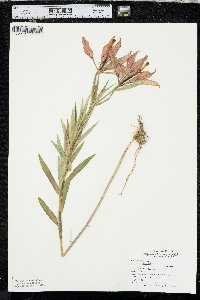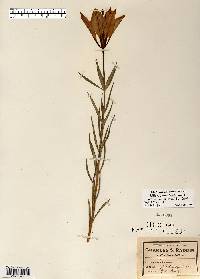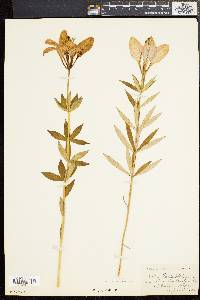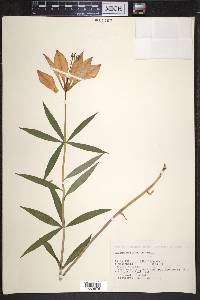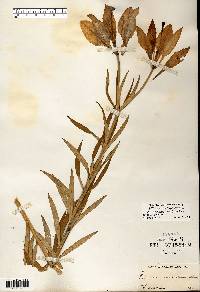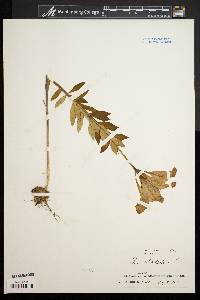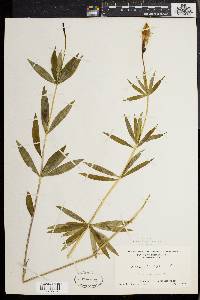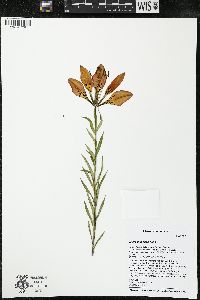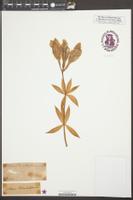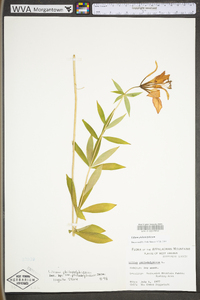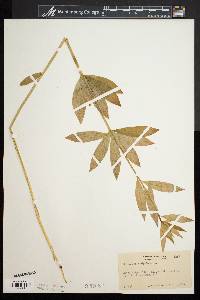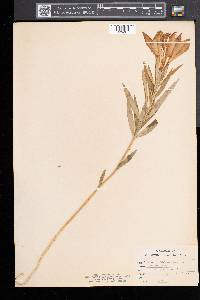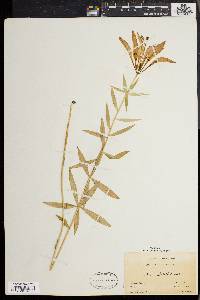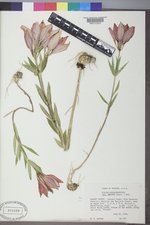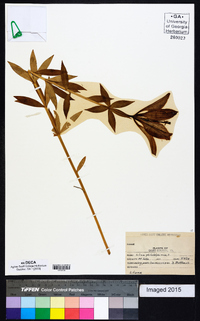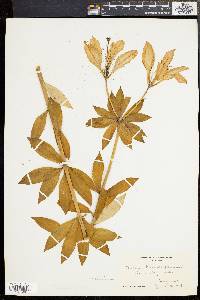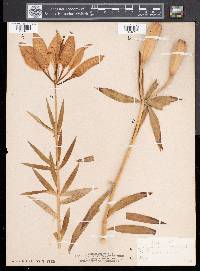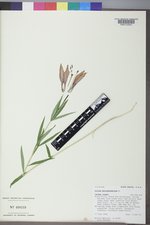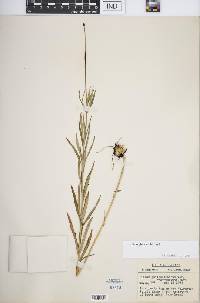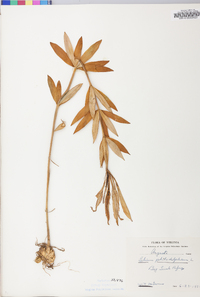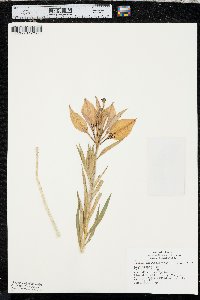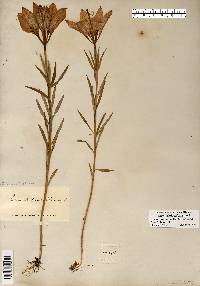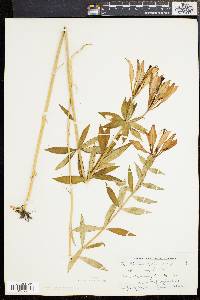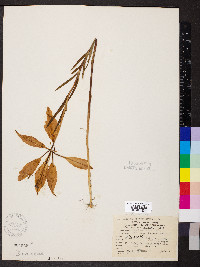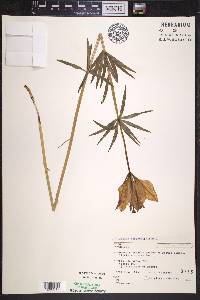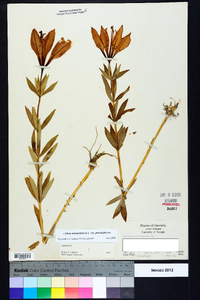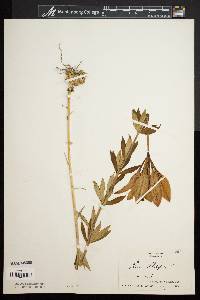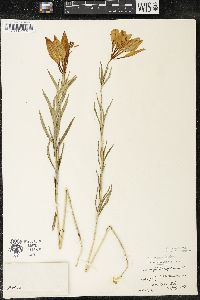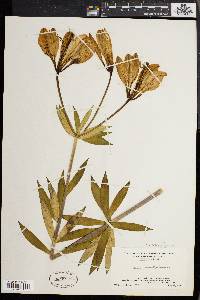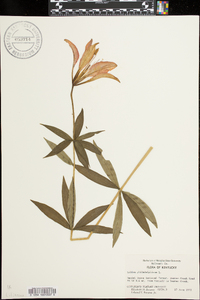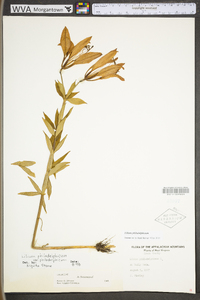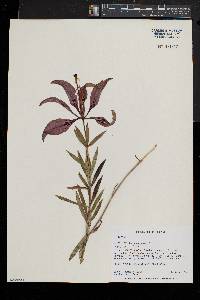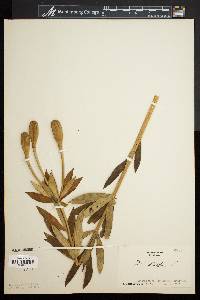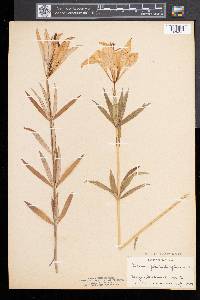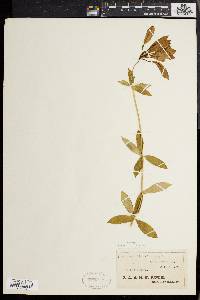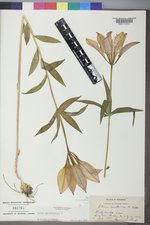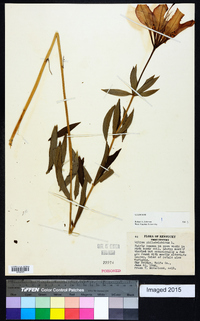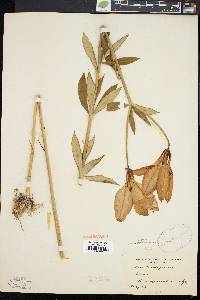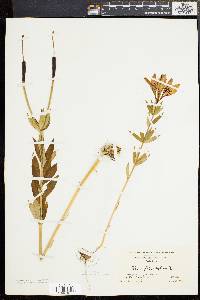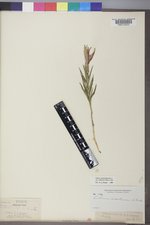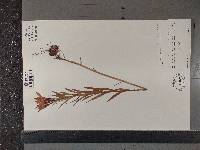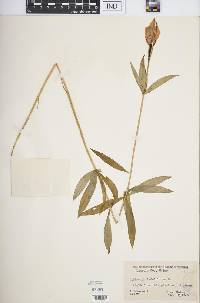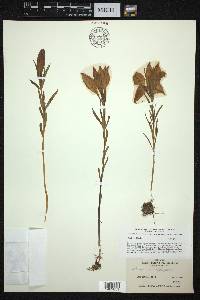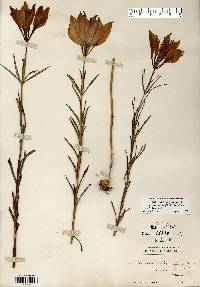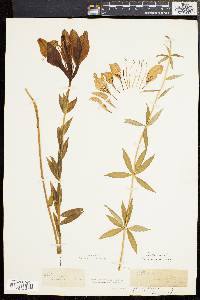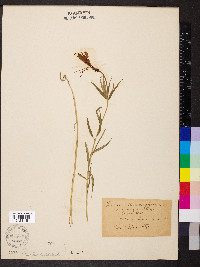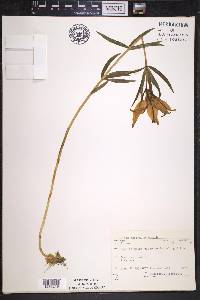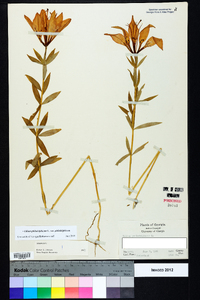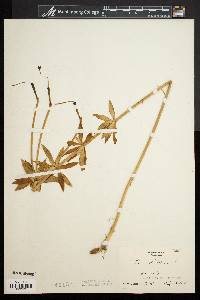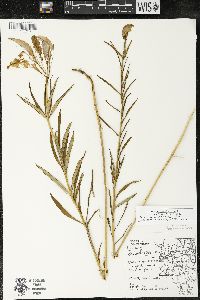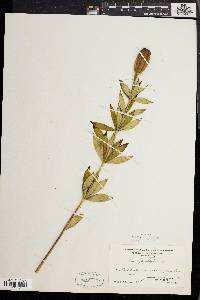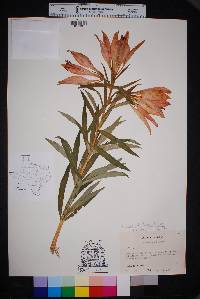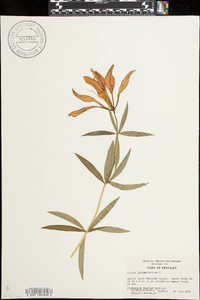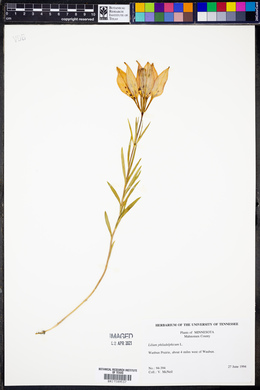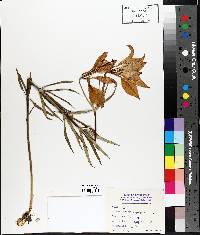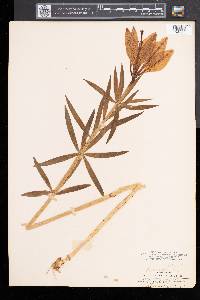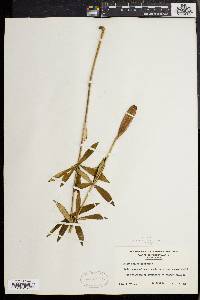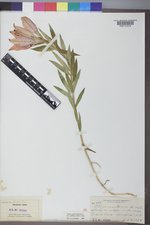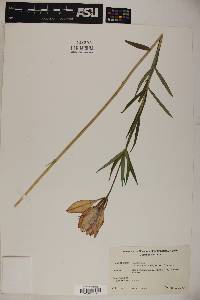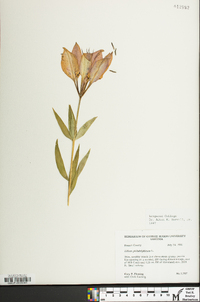Lilium philadelphicum
|
|
|
|
Family: Liliaceae
Wood Lily
[Lilium philadelphicum f. flaviflorum E.F.Williams, moreLilium philadephicum L.] |
Bulbs chunky, 1.6-2.9 × 2.2-4.7 cm, 0.6-1.1 times taller than long, 2(-4) years´ growth visible; scales 1-2-segmented, longest 1.2-2.2 cm; stem roots present or absent. Stems to 1.2 m, glaucous. Buds rounded in cross section. Leaves scattered, or mostly scattered with at least 1 distal whorl, or in 1-5 whorls or partial whorls, 3-11 leaves per whorl, ± horizontal and drooping at tips, or ascending in sun, 2.9-10.2 × 0.3-2.3 cm, 3.5-18 times longer than wide; blade narrowly elliptic, sometimes linear, elliptic, or oblanceolate, margins not undulate, apex acute or barely acuminate; veins and margins ± smooth abaxially. Inflorescences umbellate, 1-3(-6)-flowered. Flowers erect, not fragrant; perianth widely campanulate; sepals and petals somewhat recurved 1/4-2/5 along length from base, red-orange or red-magenta, sometimes pale orange, pure red, or rarely yellow, distinctly clawed, apex often widely acute, rarely obtuse, nectar guides above claws yellow to orange and spotted maroon, more pronounced on sepals; sepals not ridged abaxially, 4.9-8.2 × 1.6-2.6 cm; petals 4.5-7.7 × 2-3.2 cm; stamens strongly exserted; filaments ± parallel to style, barely spreading, diverging 0°-8° from axis, ± same color as sepals and petals; anthers dull maroon, 0.5-1.2 cm; pollen variously colored dark orange, brown, brown-yellow, or yellow; pistil 5-8 cm; ovary 1.3-3.2 cm; style ± same color as sepals and petals; pedicel 2.5-10.5 cm. Capsules 2.2-7.7 × 1-1.8 cm, 3-4.8 times longer than wide. Seeds not counted. 2n = 24. Flowering late spring--summer (late May--Aug), earliest in s Appalachians, latest in n Rocky Mountains. Tallgrass prairies, open woods, thickets, roadsides, powerlines, e balds, barrens, dunes, and heathlands, w mountain meadows; 0--2700 m; Alta., B.C., Man., Ont., Que., Sask.; Colo., Conn., Del., D.C., Ga., Ill., Ind., Iowa, Ky., Maine, Md., Mass., Mich., Minn., Mo., Mont., Nebr., N.H., N.J., N.Mex., N.Y., N.C., N.Dak., Ohio, Pa., R.I., S.C., S.Dak., Tenn., Tex., Vt., Va., W.Va., Wis., Wyo. Lilium philadelphicum is the widest ranging of our true lilies. Rather common in high meadows of the mountain west and some intact tallgrass prairies of the Great Plains and adjacent corn belt, it is decidedly rare to the east in lower midwestern prairies of the United States and in the southern Appalachians, where it is protected by several states. It has declined rapidly in the northeastern United States as prairies disappear and white-tailed deer [Odocoileus virginianus (Zimmermann), family Cervidae] continue to increase in number. In many places in the eastern U.S., the most reliable habitats are powerline right of ways that are maintained by brush-clearing. The northernmost populations are introduced along the railway from Gillam to Churchill on Hudson Bay (H. J. Scoggan 1978-1979, part 2), though the wood lily is native and widespread farther south in Manitoba. Reports from Arkansas cannot be verified, and an 1869 D. E. Palmer specimen with the locality given as Arizona was probably collected in New Mexico or Colorado. Surprisingly, there are no known records for the area extending from southwestern Iowa to southeastern Alberta. Lilium philadelphicum is highly variable in stature, leaf size and arrangement, flower color, and fruit length, and it is this variation that has accounted for the proliferation of names-only a few of which are cited above-applied to this taxon. Of these, only one remains in general use. Variety andinum has come to include usually western plants of smaller stature that have long capsules (4-8 cm vs. 2.5-3.5 cm in var. philadelphicum) and are characterized by scattered leaves usually topped by a single whorl (E. T. Wherry 1946). The typical habitat for these plants is the low grassy vegetation found in tall- and midgrass prairies and mountain meadows. The usually accepted break between this entity and var. philadelphicum runs north to south along the eastern border of Ohio (E. L. Braun 1967), and thus northeastern and Appalachian plants are normally assigned to the nominate variety. These are more often plants of open woods or thickets, though they do occur in low vegetation, including Appalachian balds and eastern prairies. Field studies show that these specimens tend to be large, with a mean stem height of 81 cm, compared to 48 cm in western plants. Leaf arrangement consists of 2-5 whorls of 3 or more leaves (averaging 3.8 whorls) as opposed to the more western plants typically assigned to var. andinum, which display 0-5 whorls, averaging 1.3 whorls per plant. Leaves are also longer and wider in these eastern and Appalachian plants and average 6.9 cm long (3.8-10.2 cm) by 1.3 cm wide (0.7-2.3 cm), compared with 5.1 cm long (2.9-7.7 cm) by 0.6 cm wide (0.3-1.4 cm) in plants sampled from western Ohio and Colorado. Other individuals disrupt this pattern. Plants from Nantucket, Massachusetts (presumably of low heath or grassland), fall within the range of variation of mountain plants from Colorado. These dwarf individuals have small flowers and short (ca. 4 cm), very narrow (ca. 0.4 cm) leaves, albeit mostly in whorls. Equally significant are massive plants of moist woods in Colorado with fully whorled, long (to 9.2 cm), and rather wide leaves (to 1.3 cm). Other Colorado plants are vegetatively indistinguishable from certain Connecticut material. Somewhat surprisingly, given its relatively modest stature, the wood lily has the longest capsules of any Lilium in North America. The largest-fruited individuals seen come from the Appalachians, not from populations otherwise assignable to the purportedly long-fruited var. andinum. Fruit lengths average larger in these robust Kentucky plants (mean 6.2 cm, range 5.1-7.7) than in western Ohio plants (mean 4.3 cm, range 3-5.8). Plants from Vermont that are clearly assignable to var. philadelphicum on the basis of leaf size and arrangement have capsules of comparable size to those in western Ohio (mean 4.1 cm, range 3.1-5.3). Therefore, it appears that local environment governs vegetative and fruit morphology to a great degree in Lilium philadelphicum, and in many cases overwhelms the presumed effect of genotype and the broad geographical patterns. Western plants from typically eastern habitats (moist woodlands) resemble eastern plants, and eastern plants from typically more western habitats (low prairie or heath) resemble western plants. The characters invoked to support the var. andinum-especially capsule length-vary continuously and somewhat independently. The status of var. andinum is unsettled and it is not accorded formal recognition here. Lilium philadelphicum is pollinated by large swallowtail butterflies, in the west by the pale swallowtail (Papilio eurymedon Lucas, family Papilionidae) and western tiger swallowtail (P. rutulus Lucas), in the east by the eastern tiger swallowtail (P. glaucus Linnaeus; E. M. Barrows 1979) and undoubtedly most of the other species resident in its wide range. Hummingbirds occasionally visit the flowers but are unlikely to be equally effective pollinators due to a flower morphology that forces butterfly forewings to contact reproductive structures but probably allows birds ready nectar access without such contact. The wood lily is the floral emblem of Saskatchewan. The Cree, Meskwaki, and Blackfoot used Lilium philadelphicum bulbs as food, while other tribes used bulbs medicinally and in witchcraft (D. E. Moerman 1986). The Malecite mixed the roots with those of Rubus species and staghorn sumac (Rhus typhina Linnaeus) to treat coughs and fevers. The Chippewa made a poultice that was applied to dog bites and caused the dog´s fangs to drop out. The Iroquois made a decoction of the whole plant to shed the placenta after childbirth, women used a decoction of the roots as a wash if the husband was unfaithful, and the whole plant was used as a romantic aid: if sun-dried plants twisted together, they signified a wife´s infidelity.
Perennial herb with a bulb flowering stem to 0.8 m tall Leaves: mostly scattered with at least one whorl towards the top, or in one to five whorls or partial whorls (three to eleven leaves per whorl), stalkless, more or less horizontal with drooping tips (ascending in the sun), 3 - 10 cm long, 0.3 - 2.3 cm wide, narrowly elliptic or sometimes linear or lance-shaped. Inflorescence: an upright, terminal umbel of one to six flowers raised on a stout stalk. Flowers: reddish orange to red-magenta (color may vary) and yellow to orange with maroon spots above the claw, to over 8 cm long and over 3 cm wide, widely bell-shaped, distinctly clawed, wide-pointed, with six tepals that are slightly curved backward. Stamens six, strongly exserted. Filaments elongate, barely spreading. Anthers dull maroon. Fruit: a three-valved dehiscent capsule, upright, brown at maturity, to nearly 8 cm long, more or less oblong egg-shaped with a constricted base. Seeds numerous and flat. Bulb: whitish, often stained brown, 2 - 3 cm thick, egg-shaped, chunky, scaly. Similar species: Lilium lancifolium is similar but has alternate, lance-shaped leaves that bear dark bulblets on the upper stem. Lilium michiganense is also similar but has many whorls of leaves, nodding flowers without clawed tepals, and a general height of over 1 m. Flowering: mid-June to mid-July Habitat and ecology: Found in prairies but becoming rare due to habitat loss. Occurence in the Chicago region: native Notes: A true prairie species of the Chicago Region with the widest range of any true lily in North America. Lilies, as a whole, are highly regarded for their beauty and are of great commercial importance. Thousands of hybrids have been developed. However, native North American species do not thrive well in gardens and many suffer from excessive collecting. It is best not to remove them from the wild. Etymology: Lilium means lily. Philadelphicum means "of or from Philadelphia." Author: The Morton Arboretum Bulb 2-3 cm thick; stems erect, 3-8 dm; lvs 5-10 cm, acuminate, at least the uppermost in a whorl of 4-7; fls 1-5, erect; tep red-orange, varying to nearly red or nearly yellow, the blade ovate to lance-ovate, 1-2 times as long as the claw, purple-spotted toward the base, acuminate or bluntly apiculate; 2n=24. June-Aug. Two well marked vars.: Var. philadelphicum, of dry open woods and thickets from N.H. to N.C. and Ky., has the lvs mostly whorled, with or without a few alternate lvs between the whorls, lanceolate to oblanceolate, 10-15(-25) mm wide, the fr 2.5-3.5 cm. Var. andinum (Nutt.) Ker Gawl. (L. umbellatum), in meadows and along shores from O. to Minn., B.C., and N.M. has the lvs mostly alternate, except in the uppermost whorl, narrowly lanceolate to linear, 3-10 mm wide, the fr 4-7 cm. Gleason, Henry A. & Cronquist, Arthur J. 1991. Manual of vascular plants of northeastern United States and adjacent Canada. lxxv + 910 pp. ©The New York Botanical Garden. All rights reserved. Used by permission. From Flora of Indiana (1940) by Charles C. Deam It is doubtful whether [Liliium philadelphicum var. philadelphicum] occurs in the state. All of the specimens I have seen belong to the variety [var. andinum (a form with linear scattered leaves rather than lanceolate, whorled leaves)] and I think all reports of it from Indiana should be referred to the variety. All of the reports of the variety [andinum] and all of my specimens are from northern Indiana. Our reports for the species, however, extend the range to Hamilton, Vigo, Monroe, Clark, and Jefferson Counties and the Lower Wabash Valley. Prince Maximilian, June 10, 1834, reported finding Lilium Catesbaei in Knox County north of Hazelton. Since this species as now known is not found in Indiana and its flowering season is much later, I think this report should be referred to L. philadelphicum var. andinum. This lily is local and all the specimens I have seen were found in wet prairies or in similar habitats. Coulter, in his report from Jefferson County, says: "Common on the sand flats." There is a specimen in the herbarium of Wabash College collected in Harrison County by Clapp. .…… Indiana Coefficient of Conservatism: C = 10 Wetland Indicator Status: FAC |

